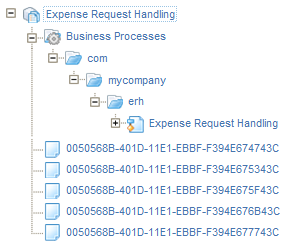Reconstructing Missing Translations |
|
The translation feature of Process Platform enables you to make specific application components translatable. This includes User Interfaces, Business Process Models, Business Identifiers, and JavaScript Message Bundles.
When developing translatable application artifacts (such as User Interfaces, Business Process Models, and Business Identifiers), the translations are stored at project level. While moving such application components to a different project, within the same workspace, the relation with their translations is still intact. However, when you decide to delete the original project, a message appears saying that some artifact from the project is still in use. On verifying, you may not find any files, as the translation files are not visible to the end user. If you continue with deleting that project, the translatable components that originate from that project get disconnected from their translations.
In BOP 4.1 CU5, the system automatically tries to reconstruct those translations whenever you open such a document. This causes those documents to be modified. In team development workspaces, this causes such documents to get locked, thereby blocking others from editing the same document. Although you can save the changes to those documents, the regenerated translation files are not stored yet. This you only find out when performing other actions that require all documents to be stored, like synchronizing the workspace with the file system, validating or publishing a document, or making changes available to others. Eventually you end up with many translation related files being stored in the project hierarchy whereas they should have been part of projects themselves without being visible to end users.

This behaviour has been corrected in BOP 4.1 CU6 (and later releases) by not automatically reconstructing the translation files any more. The developer is in control of creating translations and also of reconstructing missing translations. The downside is that the descriptions of activities in such Business Process Models cannot be shown before those lost translations are reconstructed. These problems can be solved by reconstructing the missing translations as described below.
To reconstruct the translations, you can use the Reconstruct Translations option available in the context menu of all the translatable application components.
- In the My Applications App Palette, select
 to display the Workspace Documents window. You can initiate the reconstruction process at document level or at project level in one of the following ways:
to display the Workspace Documents window. You can initiate the reconstruction process at document level or at project level in one of the following ways:
- In the Workspace Documents, right-click the required document, and select Reconstruct Translations. This will reconstruct all the missing translations in that document.
- In the Workspace Documents (Explorer) window, right-click the required project, and select Reconstruct Translations. This will reconstruct all the missing translations for all documents contained in that project.
- Based on your requirement, open the Translation Editor in one of the following ways:
- Right-click the relevant document and select Translate to open the Translation Editor.
- Right-click the relevant project and select Translate to open the Translation Editor.
The Translation editor opens displaying all the non-translated items.
Note: in case of JavaScript Message Bundles, the original texts are not available anymore; all reconstructed messages will show up as "Untitled Message".
- Provide the translations for all translatable texts in the documents.
- Click
 .
.
The translations are reconstructed.